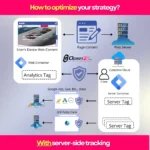In today’s digital landscape, leveraging artificial intelligence (AI) for marketing isn’t just a luxury—it’s becoming essential for businesses looking to stay competitive. AI tools can help streamline processes, enhance customer engagement, and ultimately drive better results for your marketing campaigns. The best part? Many powerful AI marketing tools are available for free, making advanced marketing strategies accessible to businesses of all sizes.
The Power of AI in Modern Marketing Strategies
AI has revolutionized how businesses approach marketing. From automated customer interactions to data-driven insights, AI empowers marketers to work smarter, not harder. Unlike traditional marketing methods that often rely on intuition and manual processes, AI marketing leverages machine learning algorithms to analyze vast amounts of data and make intelligent decisions. This technology enables personalized customer experiences at scale—something that was previously impossible to achieve efficiently.
According to recent studies, businesses that implement AI in their marketing strategies see an average of 40% improvement in productivity and a 30% increase in conversion rates. These impressive statistics highlight why AI has become a game-changer in the marketing world. As AI continues to evolve in the search landscape, marketers need to adapt and incorporate these powerful tools into their strategies.
Free AI-Powered Tools for Marketing Automation
Automated DM Generator: Enhancing Customer Engagement
Direct messaging remains one of the most effective ways to connect with your audience on a personal level. However, manually crafting personalized messages for hundreds or thousands of followers is practically impossible. This is where an Automated DM Generator becomes invaluable.
These AI-powered tools can create personalized direct messages based on user behavior, preferences, and interaction history. By analyzing past conversations and customer data, they generate messages that feel authentic rather than robotic. The result? Higher engagement rates, improved customer satisfaction, and ultimately, better conversion rates.
To implement this effectively:
- Define your customer segments based on behavior and preferences
- Create message templates for different scenarios (welcome messages, follow-ups, special offers)
- Set up automation triggers based on specific actions
- Regularly review and refine your messaging based on performance metrics
Creating Free Lead Magnets Using AI Assistants
Lead magnets are valuable offerings that encourage potential customers to share their contact information. They’re essential for building your email list and nurturing leads. Traditionally, creating high-quality lead magnets like ebooks, guides, or templates required significant time and resources. Now, AI assistants can generate these materials in minutes.
AI can help you create compelling lead magnets by:
- Analyzing trending topics in your industry
- Generating comprehensive outlines based on user search intent
- Creating polished content with minimal human supervision
- Designing visually appealing layouts and graphics
This approach to conversion rate optimization significantly reduces the time and cost associated with lead generation while maintaining high quality standards that resonate with your target audience.
Streamlining Customer Journeys with AI Onboarding
First impressions matter. A smooth onboarding process can be the difference between a one-time customer and a loyal brand advocate. AI onboarding assistants help create personalized welcome experiences that guide new users through your products or services efficiently.
These intelligent systems can adapt to each user’s behavior, offering relevant tips, tutorials, and resources based on their actions and preferences. By analyzing how users interact with your platform, AI can identify potential friction points and proactively address them, reducing customer frustration and support tickets.
The benefits of AI onboarding extend beyond customer satisfaction—they directly impact your bottom line through improved retention rates and increased customer lifetime value. When customers quickly understand how to get value from your product, they’re more likely to stick around and even upgrade their accounts.
Content Creation and Distribution with AI Technology
Viral Content Automation Using Apify
Creating content that resonates with your audience and has viral potential is often described as part art, part science. With tools like Apify, the science part becomes significantly easier. Apify is a web scraping and automation platform that can help marketers identify trending content across various platforms and automate the creation of similar content optimized for virality.
Here’s a simple step-by-step approach to leveraging Apify for viral content:
- Set up scrapers to monitor trending content in your niche
- Analyze common elements among viral posts (format, tone, topics)
- Use AI to generate content variations based on these insights
- Automate distribution across multiple platforms
- Track performance metrics to continuously refine your approach
This process helps marketers stay ahead of trends and create content with a higher likelihood of engagement, shares, and conversions. As effective SEO copywriting continues to evolve, these tools become increasingly valuable for content creators.
Data Scraping for Market Intelligence
Making informed marketing decisions requires comprehensive data. Apify’s data scraping capabilities allow marketers to gather valuable insights from competitors, industry forums, review sites, and social media platforms. This information can inform product development, pricing strategies, content creation, and campaign targeting.
Unlike manual research, which is time-consuming and often incomplete, automated data scraping provides a comprehensive view of the market landscape. When combined with AI analysis tools, this data can reveal hidden patterns and opportunities that would be impossible to identify manually.
For instance, by scraping product reviews across multiple platforms, you can identify common pain points and feature requests that your marketing can address. Similarly, analyzing competitor content performance can help you identify content gaps and opportunities in your SEO marketing strategy.
Creating an Omnipresent Content System
Today’s consumers interact with brands across multiple platforms. An omnipresent content system ensures your message reaches your audience wherever they are, creating a cohesive brand experience across all touchpoints. This approach maximizes your content ROI by repurposing and adapting core messages for different platforms.
The key to successful omnipresent content is understanding the unique characteristics and audience expectations of each platform. Content that performs well on LinkedIn may need significant modifications for TikTok or Instagram. AI tools can help analyze platform-specific trends and automatically adapt your content accordingly.
To implement an omnipresent content system:
- Create cornerstone content pieces that contain your core message
- Use AI to extract key points and adapt them for different platforms
- Maintain consistent brand voice while respecting platform norms
- Schedule content strategically to maintain presence without overwhelming your audience
- Track cross-platform performance to identify what resonates best where
This approach ensures maximum visibility while minimizing the resources required for content creation, aligning perfectly with efficient search engine marketing strategies.
Repurposing Long-Form to Short-Form Content with AI Clone
One of the biggest challenges in content marketing is maximizing the value of your content investments. Creating high-quality long-form content requires significant resources, but its reach is often limited if it’s only published in one format on one platform. AI Clone technology solves this problem by automatically transforming long-form content into multiple short-form pieces optimized for different platforms.
For example, a comprehensive blog post can be transformed into:
- Short, punchy social media posts with eye-catching visuals
- Infographics highlighting key statistics
- Short video scripts summarizing main points
- Email newsletter content
- Podcast episode outlines
This intelligent repurposing ensures your message reaches audiences with different content consumption preferences while maintaining consistency across all channels. It’s an approach that aligns with best practices for text structure in SEO.
Automating Content Publication for Maximum Efficiency
Auto Bulk Schedule Any Posts Automated
Consistent content publication is essential for building audience engagement and trust. However, manually publishing content across multiple platforms at optimal times is logistically challenging. Automated bulk scheduling tools solve this problem by allowing marketers to plan and schedule content weeks or months in advance.
Advanced AI-powered scheduling tools go beyond simple timing—they can analyze platform algorithms and audience behavior to determine optimal posting times for maximum visibility and engagement. Some even adjust posting schedules based on real-time performance data, ensuring your content always reaches the largest possible audience.
The benefits of automated scheduling include:
- Consistent content presence even during busy periods
- Optimal timing for different platforms and audience segments
- Reduced manual work for marketing teams
- Better work-life balance for social media managers
- More time for strategy and content creation
By combining this approach with effective SEO strategies, businesses can create a powerful, efficient marketing system that delivers results without requiring constant attention.
Integrating AI Tools into Your Marketing Workflow
While each AI tool offers significant benefits individually, their true power comes from integration. Creating a seamless workflow where data and content flow between different AI systems can dramatically increase efficiency and effectiveness.
For example, a well-integrated AI marketing stack might look like this:
- Market research tools identify trending topics and customer pain points
- Content generation AI creates long-form content addressing these topics
- Repurposing tools transform this content into multiple formats
- Scheduling systems publish this content across platforms at optimal times
- Engagement tools respond to comments and direct messages
- Analytics systems measure performance and feed insights back into the process
This integrated approach creates a virtuous cycle of continuous improvement, with each component enhancing the effectiveness of the others. It’s an approach that aligns perfectly with modern web design and development practices that prioritize user experience and conversion optimization.
By leveraging these free AI marketing tools and strategies, businesses of any size can compete effectively in today’s digital landscape. The key is to start small, measure results, and gradually expand your AI marketing toolkit as you become comfortable with each new technology.
Frequently Asked Questions
Are these AI marketing tools really free, or do they have hidden costs?
Most of the tools mentioned offer genuinely free versions with limitations on usage volume or features. These free versions are often sufficient for small businesses or those just starting with AI marketing. As your needs grow, you might consider upgrading to paid plans for additional capabilities, but you can achieve significant results with just the free versions.
Do I need technical skills to implement these AI marketing strategies?
Most modern AI marketing tools are designed with non-technical users in mind, featuring intuitive interfaces and step-by-step guides. While basic digital literacy is helpful, you don’t need programming or data science skills to benefit from these technologies. Many platforms offer templates and workflows that make implementation straightforward.
How much time does it take to see results from AI marketing tools?
The timeline varies depending on your starting point, industry, and specific goals. Some benefits, like time savings from automation, are immediate. Content optimization might show results within weeks as search engines index your content. Customer engagement improvements typically become apparent within the first month of implementation. For comprehensive marketing transformation, expect a 3-6 month journey.
Can AI marketing tools completely replace human marketers?
No, AI tools are designed to augment human capabilities, not replace them. While AI excels at data analysis, pattern recognition, and routine task automation, human marketers remain essential for strategy development, creative direction, emotional intelligence, and ethical oversight. The most effective marketing approaches combine AI efficiency with human creativity and judgment.
 Written by: Romulo Vargas Betancourt
Written by: Romulo Vargas Betancourt
CEO – OpenFS LLC







